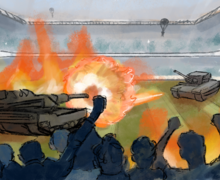How Syracuse, one of the country’s tallest backcourts, plays against smaller guards
Alexandra Moreo | Senior Staff Photographer
Frank Howard, defending Kyle Guy of Virginia, is one of the taller guards in the ACC.
Frank Howard has been watching a lot of film lately, and he developed a startling conclusion: He should play bigger.
Smaller guards force him to be “over-quick,” the 6-foot-5-inch tall Howard said. What he means exactly is that smaller guys can speed him up. They can more easily jab, hop back and forth and they try to get lower than him to pick up a steal. Howard can see above smaller defenders when shooting and creating offense, but shorter players may sneakily get a hand on the basketball in the lane.
“With me attacking, I need to start using my size again,” Howard said. “Put defenders on my hip, try not to do too much to totally beat them. Just use my size advantage, try to incorporate that.”
Howard and fellow backcourt mate 6-foot-6-inch Tyus Battle have the double-duty of both anchoring Syracuse’s (17-8, 6-6 Atlantic Coast) offense and the top of its 2-3 zone. Oftentimes, they match up against guards a few inches shorter, which means they both almost always defend and shoot against players who physically look up to them. Both Battle and Howard say the primary goal is to exploit the inherent size advantage they have. Given their importance to everything SU does on both ends of the floor, how well they exploit that advantage will influence much of Syracuse’s overall play in the final weeks of the regular season.
Syracuse head coach Jim Boeheim said that smaller players are no quicker than taller players. But SU players said shorter guys can hide between or behind taller players like Battle and Howard, putting themselves in position to poke the ball out on defense or dribble through tight spaces on offense.
Howard, point guard of the tallest team — by average height — in the country, per Kenpom.com, said the floater is an effective way to combat how small guards defend. They have no chance at stripping the ball, he said. Whereas if he were to lay a ball off the glass, it may be easier for the defender to alter the ball as Howard brings it from the lower, more vulnerable spot on his hip.
“When you’ve got smaller guards,” SU associate head coach Adrian Autry said, “the only play they can make is at the ball. (Assistant coach Gerry McNamara) talks about making sure you protect that ball strong, because that’s the only play they can really make. There’s nothing else they can do.”

Kevin Camelo | Digital Design Editor
Battle, who averages a team-high 20.3 points per game, said he doesn’t change much of his approach against shorter guards. He feels he can get past anyone to the basket. But he tends to anticipate when shorter defenders play closer. They hold onto you longer through the lane, he said. They nag at the ball.
Taller guards like those in SU’s backcourt may not find extra space just by dribbling more, Autry noted. Bounces give smaller guys an opportunity to get a hand in. Thus, Battle said he tries to beat defenders with a quick first step by getting his lead foot out long and low. This gives him the power to drive off and cover a greater distance toward his final destination: the basket.
Then there’s defense. The success of Boeheim’s 2-3 zone rests heavily on activeness, which Boeheim discusses after nearly every game. Chances are that if his guards were active, SU won the game or played close. Boeheim said smaller guards don’t change anything he teaches his players or how they operate. But he later said that when guards hit shots, his guys need to push out to contend. By chasing them off the perimeter, opponents feel forced to enter the paint, where SU bigs roam. Putting activeness at the forefront is integral to stopping shorter, quick guards.
“At times we don’t use our length to disrupt them,” Autry said. “Just need to keep them in front of us. We’re tall, but (opponents) are just as fast and athletic. They can space us out a little bit, so we just have to be active with our hands.”
The combined wingspan of Battle and Howard side-by-side can make entry passes into the high post difficult. That’s the goal: minimize inside-outside ball movement against the zone. Because they usually have a couple of inches in height advantage, Syracuse’s guards also strive to contest 3-pointers. Not necessarily to block shots, but to contest. Every inch counts.
“We’re one of the tallest Syracuse teams in a while,” Battle said. “We’ve got to utilize that.”
Published on February 13, 2018 at 10:41 pm
Contact Matthew: mguti100@syr.edu | @MatthewGut21





